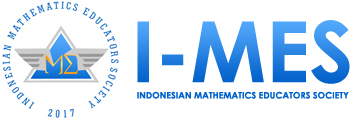Fun Math Learning For Elementary School Students Through Interactive Puzzle Media
DOI:
https://doi.org/10.35706/sjme.v6i1.5775Abstract
Amid the covid-19 pandemic, teachers and students should undergo an educational transformation which suddenly force them to embrace digital learning to support an online mode of teaching. In mathematic context, teachers can make use of interactive puzzle media as one of the digital tools that may stimulate activeness, mathematical understanding, and fun math learning for students. The purpose of this study is therefore to unearth the students’ reception during mathematics instruction using the media. This descriptive qualitative research involved 30 first graders of elementary school in West Java, Indonesia and employed questionnaire, interview, and video-based observation to collect the data. The research findings showcase that learning mathematics using interactive puzzle media is enjoyable for students, and there is a strongly positive response from 80% of them which can be seen from the activeness and enthusiasm demonstrated during the learning process. It further indicates that the application of interactive puzzle media increases students' confidence, fosters learning motivation, develops self-reliant learning, and provides clearer understanding of recognizing the concept of numbers and recognize the concept of numbers and geometric shapes. With these specialties, interactive puzzle would be appropriate instructional media and technology for learning. Interactive puzzle media can be accessed online through http://bit.ly/MediaPuzzleInteraktif
Downloads
References
Abristiana, P. O., Kristanti, A., & Aisyatul W., A. (2020). Pengenalan Angka Menggunakan Permainan Puzzle dan Pengaruhnya Terhadap Perkembangan Emosi dan Kemampuan Motorik Halus Anak Usia Dini di Play Group Se-Kecamatan Sumbersari Kabupaten Jember. Laplace : Jurnal Pendidikan Matematika, 3(1), 70–86. https://doi.org/10.31537/laplace.v3i1.314
Aisyah, S., & Yultas, N. S. (2019). Efektifitas Penerapan Metode Bermain dengan Media Puzzle dalam Meningkatkan Kemampuan Kognitif Anak. Jurnal Kajian Ilmu Kependidikan, 12(2), 226–239.
Akmaluddin, & Fajri, R. (2019). Pengembangan Karakter Anak Berdasarkan Media Puzzle di Tpa Baitul Munawwarah Gampong Tibang Kecamatan Syiah Kuala Kota Banda Aceh. Jurnal Pengabdian Masyarakat (Pendidikan), 1(2), 1–7.
Anisa, R. N., Ambarwati, L., & Deasyanti. (2020). Pembelajran Matematika Siswa Sekolah Dasar Melalui Kegiatan Bermain. JPD: Jurnal Pendidikan Dasar, 1–11.
Cahyadi, F., & Hernita, M. I. (2016). Peningkatan Keaktifan dan Kemampuan Berhitung melalui Media Puzzle pada Anak. American Journal of Orthodontics and Dentofacial Orthopedics, 20(1), 1–8. Retrieved from https://doi.org/10.1016/j.ajodo.2017.09.016
Chang, Y. H., Hwang, J. H., Fang, R. J., & Lu, Y. Te. (2017). A kinect- and game-based interactive learning system. Eurasia Journal of Mathematics, Science and Technology Education, 13(8), 4897–4914. https://doi.org/10.12973/eurasia.2017.00972a
Devi, N. M. I. A. (2020). Pengembangan Media Pembelajaran Puzzle Angka untuk Meningkatkan Kemampuan Mengenal Lambang Bilangan. Jurnal Ilmiah Pendidikan Profesi Guru, 3(3), 416. https://doi.org/10.23887/jippg.v3i3.28331
Dewi Nur, I. R., Nina Yulian, V., & Laelasari, L. (2021). An analysis of Elementary School Students Errors in Solving Statistics Problems in Online Learning during a Pandemic Period. SJME (Supremum Journal of Mathematics Education), 5(2), 207–214. https://doi.org/10.35706/sjme.v5i2.5302
Dwi Permata, R. (2020). Pengaruh Permainan Puzzle Terhadap Kemampuan Pemecahan Masalah Anak Usia 4-5 Tahun. PINUS: Jurnal Penelitian Inovasi Pembelajaran, 5(2), 1–10. https://doi.org/10.29407/pn.v5i2.14230
Eshet-Alkalai, Y. (2004). Digital Literacy: A Conceptual Framework for Survival Skills in the Digital era. Journal of Educational Multimedia and Hypermedia, 13(1), 93–106.
Fitri, A., Nurhafizah, & Yaswinda. (2020). Pengaruh Media Puzzle Angka Modifikasi terhadap Kemampuan Berhitung Anak Taman Kanak-Kanak. Jurnal Pendidikan Tambusai, 4(1), 7–13.
Hendra Saputra, V., & Pasha, D. (2021). Komik Berbasis Scientific Sebagai Media Pembelajaran di Masa Pandemik Covid-19. SJME (Supremum Journal of Mathematics Education), 5(1), 85–96. https://doi.org/10.35706/sjme.v5i1.4514
Inventado, P. S., Scupelli, P., Heffernan, C., & Heffernan, N. (2017). Feedback design patterns for math online learning systems. ACM International Conference Proceeding Series, Part F1320, 1–15. https://doi.org/10.1145/3147704.3147738
Mahardikha, Asrori, M., & Yuniarni, D. (2013). Permainan Edukatif dengan Media Puzzle Mengembangkan Kemampuan Kognitif Anak Usia 4-5 Tahun TK Islamiyah. Jurnal Pendidikan Dan Pembelajaran Khatulistiwa, 2(10), 1–10.
Mahmud, M. R., & Pratiwi, I. M. (2019). Literasi Numerasi Siswa Dalam Pemecahan Masalah Tidak Terstruktur. KALAMATIKA Jurnal Pendidikan Matematika, 4(1), 69–88. https://doi.org/10.22236/kalamatika.vol4no1.2019pp69-88
Martin, A. ., & Madigan, D. . (2007). Digital Literacies for Learning. Journal of Information Literacy, 1(3), 1–3.
Miller, T. (2018). Developing numeracy skills using interactive technology in a play-based learning environment. International Journal of STEM Education, 5(1). https://doi.org/10.1186/s40594-018-0135-2
Pahanael, A., & Wijayaningsih, L. (2020). Upaya Meningkatkan Kreativitas Anak melalui Permainan Puzzle Stick Bar Tiga Dimensi di TK B2 Kristen 1 Satya Wacana. Jurnal Ilmiah Potensia, 5(2), 145–152.
Putra, L. D., & Ishartiwi, I. (2015). Pengembangan Multimedia Pembelajaran Interaktif Mengenal Angka Dan Huruf Untuk Anak Usia Dini. Jurnal Inovasi Teknologi Pendidikan, 2(2), 169–178. https://doi.org/10.21831/tp.v2i2.7607
Safitri, N. A. linda, Leksana, D. M., & Jihansyah, I. (2020). Pengaruh Permainan Puzzle Hitung terhadap Kemampuan Mengenal Lambang dan Nama Bilangan Anak Usia Dini. SAWABIQ: Jurnal Keislaman, 1(1).
Sattriawan, A., Sutiarso, S., & Rosidin, U. (2020). Pengembangan Media Pembelajaran Interaktif Terintegrasi Soft Skills Dalam Meningkatkan. Jurnal Cendekia: Jurnal Pendidikan Matematika, 04(02), 950–963.
Suarti, N. K. A. (2015). Bermain Puzzle Memupuk Sikap Kemandirian Pada Anak Usia Dini. Jurnal Paedagody, 2(1), 13–21. Retrieved from http://ojs.ikipmataram.ac.id/index.php/pedagogy/article/view/3044
Suciningrum, R., Slamet, S. Y., & Hartono. (2020). Crossword Puzzle-Based Utilization of ICT as an Innovation in Learning in Primary Schools. STEMEIF (Science, Technology, Engineering Ann Mathematics Learning International Forum), 3(2), 256–260. Retrieved from https://proceedings.pgsd.ump.ac.id/index.php/stemeif/article/view/34
Sujana, A., & Rachmatin, D. (2019). Literasi Digital Abad 21 Bagi Mahasiswa PGSD: Apa, Mengapa, dan Bagaimana. Conference Series Journal, 1(1), 1–7. Retrieved from https://ejournal.upi.edu/index.php/crecs/article/view/14284
Syafdaningsih, & Utami, F. (2020). Educational Game Tools in Early Childhood Mathematics Learning. AtlantisPress, 513, 227–232.
Watanabe, N. (2019). Effective Simple Mathematics Play at Home in Early Childhood: Promoting both Non-cognitive and Cognitive Skills in Early Childhood. International Electronic Journal of Mathematics Education, 14(2), 401–417. https://doi.org/10.29333/iejme/5739
Downloads
Published
How to Cite
Issue
Section
License

This work is licensed under a Creative Commons Attribution-ShareAlike 4.0 International License.
Authors who publish with this journal agree to the following terms:
- Authors retain copyright and grant the journal right of first publication with the work simultaneously licensed under a Creative Commons Attribution License that allows others to share the work with an acknowledgment of the work's authorship and initial publication in this journal.
- Authors are able to enter into separate, additional contractual arrangements for the non-exclusive distribution of the journal's published version of the work (e.g., post it to an institutional repository or publish it in a book), with an acknowledgment of its initial publication in this journal.
- Authors are permitted and encouraged to post their work online (e.g., in institutional repositories or on their website) prior to and during the submission process, as it can lead to productive exchanges, as well as earlier and greater citation of published work (See The Effect of Open Access).











